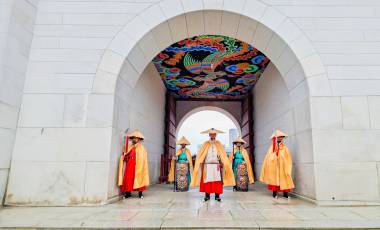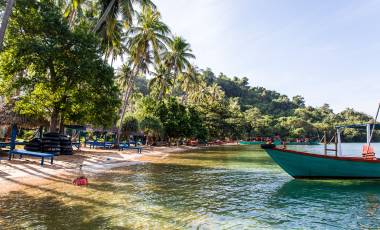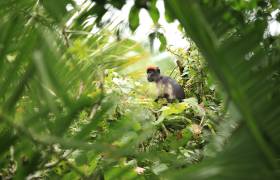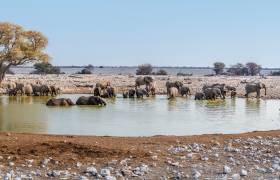In the past, South Korea may have been the lesser-visited country when ranked against other Asian destinations like Thailand or Japan, but “the Land of the Morning Calm” has increased in popularity in recent years thanks to its rich cultural heritage, spectacular national parks and fascinating high-tech districts. From the tranquil temples of Gyeongju and lush valley trails in Seoraksan National Park to the futuristic neon-lined streets of Seoul and lively markets in Busan, you’ll find that South Korea has something for everyone. You can explore exquisite royal palaces, tuck into traditional Korean cuisine and immerse yourself in the vibrant K-pop culture all in one trip. So, read on to find out South Korea’s 5 unmissable sites that we cover in our epic Discover South Korea adventure.

1. Seoul – the bustling capital of South Korea
This dynamic metropolis effortlessly blends, skyscrapers, ancient temples and palaces, making it a fascinating place to visit. On days one and two of our Discover South Korea trip, you’ll get to explore the top highlights of the country’s capital, with your expert local guide giving you insider knowledge into the city’s remarkable history and culture.
After an evening of indulging in local delicacies at Gwangjang Market, one of the largest food markets in South Korea, you and your group will enjoy a full-day tour of Seoul. Starting at the peaceful Cheonggyecheon Stream, an 11km-long urban oasis that flows through the city, you’ll discover its walking paths and beautiful art installations before heading to Tapgol Park. This park was the birthplace of Korea’s March 1st Independence Movement in 1919. Here, you’ll see the breathtaking Palgakjeong Pavilion and the Wongaksa Pagoda, alongside stark monuments that commemorate the resistance fighters who fought against Japanese colonial rule. Another highlight of the tour is a trip to Insadong – one of the main cultural districts known for its traditional teahouses, beautiful antique shops and vibrant art galleries. This place is also great for trying traditional street food like Dak-kkochi, Eomuk and Bungeo-ppang.
Nearby, you’ll visit Jogyesa Temple, the central temple of Korean Zen Buddhism, known for its colourful lanterns and relaxing atmosphere. Afterwards, your group will continue to Gwanghwamun, the towering main gate of Gyeongbokgung Palace, one of the most iconic royal palaces in Seoul. Take your time exploring the National Palace Museum and the National Folk Museum inside the complex, and explore its spectacular palace grounds, where you’ll find the Gyeonghoeru Pavilion and the Throne Hall. The full-day tour comes to a close with a walk around the enchanting Bukchon Hanok Village. This historic neighbourhood is renowned for its well-preserved traditional hanok houses from the Joseon Dynasty (1392–1910). Walking through these streets is like taking a journey back in time. Today, you’ll find the Bukchon Hanok village filled with quaint art studios and cultural museums, like the Bukchon Cultural Centre, which provides more insight into the history of the village.

2. Panmunjom and the DMZ (Demilitarised Zone)
On day three of our Discover South Korea trip, you’ll visit Panmunjom and the DMZ (Demilitarised Zone) for a harrowing glimpse into the ongoing conflict between North and South Korea. The DMZ is a 250 km-long buffer zone established after the Korean War, where the peace treaty was signed in 1953.
Today, it still maintains a heavy military presence. Within the DMZ, Panmunjom’s Joint Security Area (JSA) is where soldiers from both nations stand face-to-face. Guided by a local JSA-specialised expert, you will visit the Blue Barrack Conference buildings that straddle the border, the Dora Observation post and the Bridge of No Return, which was initially used for prisoner exchanges at the end of the Korean Armistice in 1953, and once they crossed, they’d never be allowed to interact again. On the tour, you’ll learn about the sobering history and ongoing geopolitical tensions between North and South Korea, and how the DMZ remains one of the most guarded areas in the world.
Please note: At time of publishing the Joint Security Area is closed but could re-open at any time. Entry into the DMZ area itself is open and other key sites such as the Third Tunnel are still possible to visit.

3. Gyeongju – “the museum without walls”
Another key place you’ll spend some time in during our South Korea trip is Gyeongju, the ancient capital of the Silla Kingdom ((57 BC – 935 AD). Commonly described as “the museum without walls”, this region is one of the country’s most historically- rich cities, filled with striking tombs, colourful temples and ancient UNESCO World Heritage sites that are waiting to be explored.
With your expert local guide, you’ll walk around Tumuli Park on day seven, to see the grassy burial mounds and royal tombs of Silla kings. You’ll also visit Cheomseongdae, the oldest existing astronomical observatory in Asia, which stands as a testament to the kingdom’s major scientific achievements that they used to observe astronomical events and celestial bodies. The 362 stones, signify the 362 days in the lunar calendar, and it was designed with 12 layers to reflect the 12 months of the year.
The following day, you’ll explore the Seokguram Grotto, which is carved into the side of the Tohamsan Mountain. Inside, you’ll find the majestic Central Buddha Statue, seated in the lotus position, surrounded by guardians, deities and bodhisattvas. Built in the 8th century during the Silla Dynasty, the Seokguram Grotto remains one of the country’s key religious sites, as it signifies a turning point in Korean history, where Buddhism was integrated into the state’s governance and culture. Next, you’ll explore the Bulguksa Temple, where you can admire its main hall (Daeungjeon) and the two striking pagodas of Seokgatap and Dabotap. Another key architectural marvel you’ll walk around is the Anapji Pond, where lotus blossoms cover its picturesque corners. Excavations around the pond unearthed fascinating relics including gold crowns, a royal barge, scissors and more, which you can find showcased in the Gyeongju National Museum.

4. Seoraksan National Park
Alongside its fast-paced tech cities and ancient temples, South Korea is also renowned for its natural beauty, and one of the best national parks to visit is Seoraksan National Park. Situated in the northeastern region of South Korea, the park boasts sweeping valleys, jagged granite peaks and tumbling waterfalls – making it a stunning place to explore.
On day five, you’ll get to visit this park for yourself and choose from either a 2km trail walk or a 10km walk. While you’re here, you’ll also get to see the Sinheungsa Temple and its towering bronze Budda statue which was constructed in 1997 as a symbol of hope for peace and reunification in Korea. You and your group have the option to take the cable car up to the Gwongeumseong Fortress, which offers sweeping vistas that extend over the rolling terrain and the Seoraksan Mountain Range.

5. Busan
No trip to South Korea is complete without a visit to its second-largest city – Busan. Known for its breathtaking coast and vibrant food scene, you’ll get to visit this fascinating city on day 10 of our Discover South Korea trip. After waking up early to take part in a Buddhist ceremony at the Haeinsa Temple, you’ll be driven towards Busan, where you’ll enjoy a city tour with your expert local guide. After admiring the views from Gwangalli Bridge, you’ll delve into part of the country’s tragic history with a visit to the UN Memorial Cemetery, that honours fallen soldiers of the Korean War (1950-1953). Next, you’ll stop at the Nurimaru APEC House, a high-tech conference centre which has hosted world leaders.
In the afternoon, your group will get time to explore the bustling Jagalchi Fish Market, one of the largest seafood markets in Korea. Located along Busan’s Nampo Port, you’ll see an impressive variety of fresh catches on display, including octopus, squid, sea urchins and sea cucumbers. If you’re feeling adventurous, you can pick from the fish on offer, and the vendors will prepare it for you on the spot. The market is known for its Korean sashimi, which is often served with gochujang (red pepper paste) and ssam (lettuce wraps).
Adjacent to the fish market is the traditional Gukje Market, which has been running ever since the aftermath of the Korean War. Selling traditional crafts, souvenirs, clothing and delicious street food, it’s a fascinating place to people watch and browse their eclectic mix of goods. Once your group has had dinner, you could take an optional trip up to the top of Busan Tower, one of the city’s most iconic landmarks situated in Yongdusan Park. From the observation deck, you’ll be able to see the illuminated lights of the Busan Port, the Gwangalli Bridge, the city’s towering skyscrapers and the silhouette of the surrounding mountains and coastline.
So, if we’ve inspired you to take in the highlights of this beautiful country, our Discover South Korea trip ticks all of the boxes. Find out more about this adventure here.






